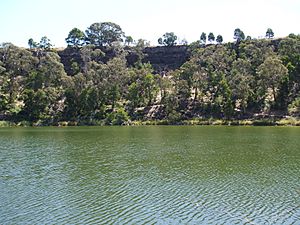Budj Bim facts for kids
Quick facts for kids Budj Bim |
|
|---|---|
| Mount Eccles | |
| Highest point | |
| Elevation | 178 m (584 ft) |
| Geography | |
| Location | Victoria, Australia |
| Climbing | |
| Easiest route | Lava Canal track |
| Official name: Budj Bim National Heritage Landscape | |
| Designated: | 20 July 2004 |
| Official name: Budj Bim Cultural Landscape | |
| Type: | Cultural |
| Criteria: | iii, v |
| Designated: | 6 July 2019 (43rd session) |
| Reference #: | 1577 |
| State Party: | |
| Region: | Asia-Pacific |
Budj Bim, also known as Mount Eccles, is a dormant volcano in southwestern Victoria, Australia. It's near a town called Macarthur. This volcano is part of Australia's youngest volcanic area, which stretches from western Victoria to south-eastern South Australia.
Budj Bim is located inside the Budj Bim National Park. The name "Budj Bim" comes from the Gunditjmara people, and it means "High Head". This peak is a cone-shaped hill made of volcanic rock called scoria. It stands about 178 meters (584 feet) tall. Next to it are three old volcanic craters that now hold a lake called Lake Surprise.
When Budj Bim erupted, it created huge lava flows. These flows, known as the Tyrendarra lava flow, changed how water moved through the land. They also formed large wetlands, which are areas of land covered by shallow water.
Many areas around the mountain are now protected because they are very important historically and culturally. These Budj Bim heritage areas include the Tyrendarra Indigenous Protected Area, the Budj Bim National Heritage Landscape, and the Budj Bim Cultural Landscape. The Budj Bim Cultural Landscape was even named a UNESCO World Heritage Site in 2019!
Contents
How Budj Bim Formed
Budj Bim is part of a large volcanic area called the Newer Volcanics Province. This area covers about 15,000 square kilometers (5,800 square miles). It has over 400 small shield volcanoes and volcanic vents, making it home to Australia's youngest volcanoes.
Scientists have studied the age of Budj Bim's eruption for a long time. Early ideas suggested it erupted between 6,000 and 27,000 years ago. More recent studies, using a method called argon–argon dating, show that the eruption happened around 36,900 years ago. This is a very old date!
This new dating is important because human tools have been found under volcanic ash at a nearby volcano called Tower Hill. This suggests that people were living in Victoria at least 36,900 years ago. It also supports the Gunditjmara people's oral histories, which are stories passed down through generations. These stories talk about volcanic eruptions and are some of the oldest oral traditions known.
The lava flow from Budj Bim, called the Tyrendarra lava flow, traveled about 50 kilometers (31 miles) south towards the ocean. This flow changed the paths of rivers and creeks. It created a complex landscape of swamps and wetlands.
Ancient History and Culture
The Budj Bim volcano and its lava flows are incredibly important to the local Gunditjmara people. Their creation story is linked to the volcano's eruption over 30,000 years ago. They believe an ancestral creator-being named Budj Bim was revealed during this event.
The Tyrendarra lava flow created large wetlands, which the Gunditjmara people used in an amazing way. For thousands of years before Europeans arrived, they built a clever system to catch eels and fish. They dug channels, built weirs (small dams), and created traps to guide water from Darlot Creek into low-lying areas. One of these eel trap systems at Lake Condah is about 6,600 years old!
This discovery shows that the Indigenous people were not just hunter-gatherers. They were also skilled engineers and farmers who managed the land and its resources. They used these techniques to farm eels, which was a very advanced way of living.
Sadly, many Gunditjmara people were later moved to the Lake Condah Mission. This was a government-run place that separated some children from their families. These children became part of what is known as the Stolen Generations.
Protected Areas
Several special areas around Budj Bim are protected. These areas help preserve the natural and cultural history of the region:
- Indigenous Protected Areas (IPAs): These are lands managed by Indigenous people.
- The Tyrendarra IPA (about 248 hectares or 613 acres) was created in 2003.
- Kurtonitj IPA was created in 2009.
- Lake Condah IPA, which includes important wetlands, was created in 2010.
- Budj Bim National Heritage Landscape: This larger area was added to Australia's National Heritage List in 2004. It includes the Tyrendarra area and the Mount Eccles Lake Condah area.
- Budj Bim Cultural Landscape: This is the biggest and most important protection. It was added to the World Heritage List in 2019. This means it's recognized as having outstanding value to all of humanity. It includes the Budj Bim National Park, the Budj Bim Indigenous Protected Area, the Tyrendarra Indigenous Protected Area, and the Lake Condah Mission.
Naming Mount Eccles
The mountain was first named Mount Eeles in 1836 by an explorer named Major Thomas Mitchell. He named it after a soldier he knew. However, a mistake by a draftsman meant the name was written as Eccles from 1845 onwards.
See also




